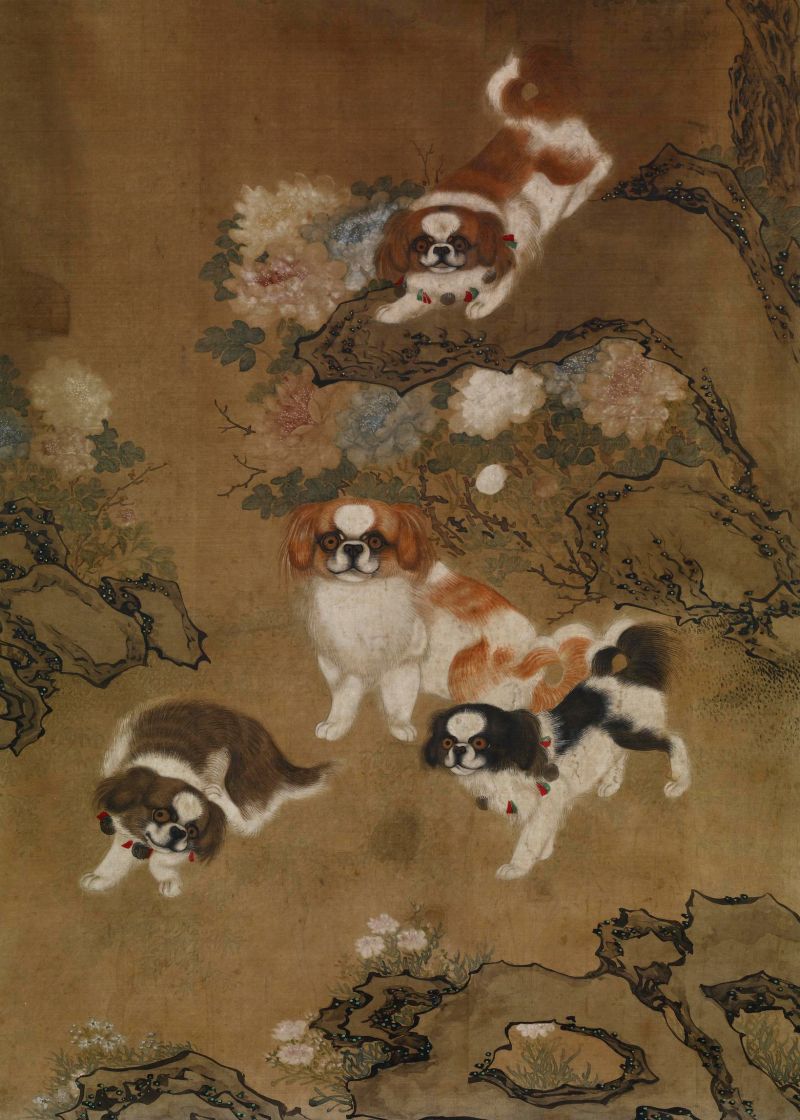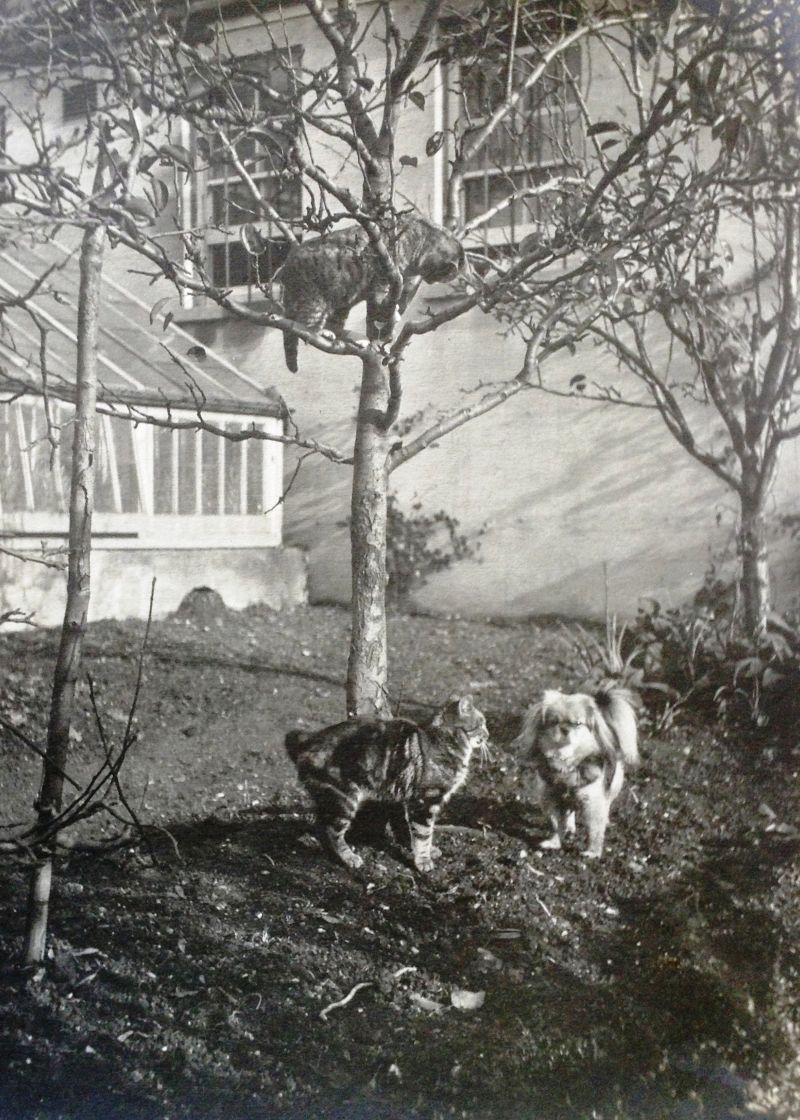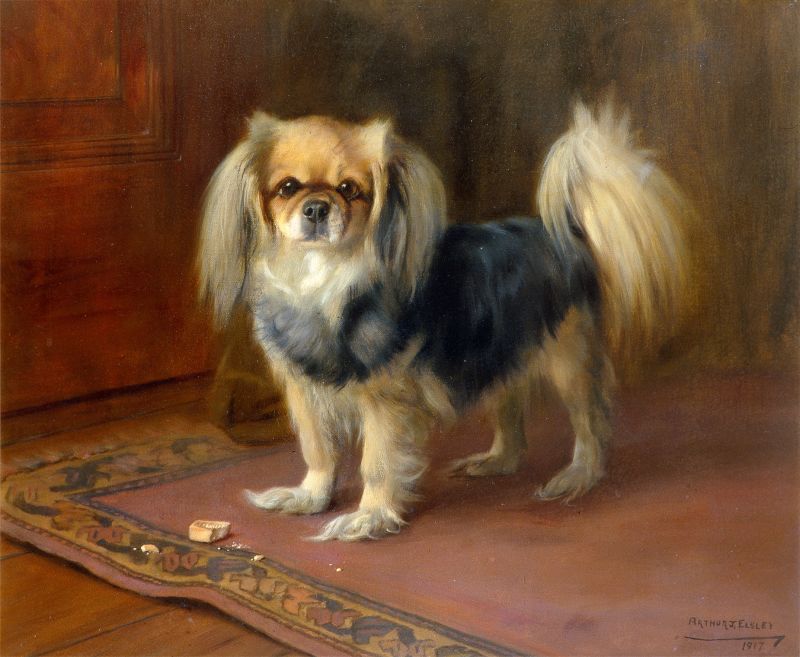
Pawfectly Plundered: Unraveling the British Frenzy of a Stolen Chinese Canine

A Pekingese dog gifted to Queen Victoria in the 1860s triggered a luxury craze among Britain's elite Despite its gentle nature, the dog's dark history adds intrigue to this tale of fantasy, nostalgia, and shifting societal perceptions
In a painting from 1861, commissioned by Queen Victoria of Britain, a Pekingese dog, with its brown and white coat, sits gracefully on a cushion in front of a Japanese vase, looking off into the distance. The dog was admired for its cute flattened snout and lion-like characteristics, and it was a new addition to the queen's collection of dogs. This particular breed of toy dog had never been seen before in Great Britain and soon became incredibly popular among the wealthy upper class as a coveted luxury item.
However, behind the Pekingese's calm and gentle nature, there lies a dark and tumultuous history.
A year prior to the completion of the painting by German artist Frederick William Keyl, the Old Summer Palace in Beijing was invaded and destroyed by Anglo-French forces. The palace, known as the "Garden of Perfect Brightness," covered an area of 860 acres. According to legend, as the Xianfeng Emperor and his court fled from the invaders, an elderly aunt chose to remain behind and ended her life in her quarters, surrounded by a loyal litter of Pekingese puppies. The soldiers rescued the dogs, along with numerous other stolen treasures, and transported them to the West.
Although this origin tale may be partially untrue, it is certain that the Pekingese depicted in the painting was brought to Britain by Captain John Dunne of the 99th Regiment. The regiment was involved in the plundering of the palace, as per orders to avenge the deaths of several British envoys by the ruling Qing dynasty government of China.
"People say it is the most perfect little beauty they ever saw," he wrote of the dog in his journal. Dunne gifted her to the queen, and the animal was given a new name: Looty.
Pekingese dogs depicted in a 19th-century Chinese hanging scroll.
The Trustees of the British Museum
Looty's arrival, along with other Pekingese dogs brought to or bred in Britain, caused a frenzy among high society women that persisted long after Queen Victoria's passing. From 1914 to 1962, the Pekingese became the most favored toy breed in Britain, with a peak of 5,809 dogs registered by the Kennel Club in 1950.
During the Edwardian era of the early 1900s, one aristocrat reportedly spent an astronomical sum, equivalent to over £300,000 ($365,000) in today's currency, for just a few dogs. This information is noted in the 1954 book "Pekingese Scrapbook." Among the British population, the dogs were highly sought-after as mementos of "Old China" - a romanticized and mystical perception of a diminishing imperial nation that succumbed to the Opium Wars, collapsed in 1911, and gave way to a Chinese republic.
The last Chinese emperors watch surpassed expectations, selling for $6.2 million at auction. As a result, the Pekingeses breed became highly sought after. According to Sarah Cheang, a design historian at the Royal College of Art in the UK, the dogs were advertised as having been smuggled out of China, adding to their allure. They were associated with sensational stories of theft by palace servants. Additionally, enthusiasts attributed what Cheang called stereotypically "oriental" characteristics to them, such as a fear of thunderstorms due to traumatic experiences in tropical typhoons. It was even suggested that Pekingeses dogs, often referred to as "pekes," refused to mate with dogs of different colors because they were aware of the sacredness of yellow, the color of the Chinese emperor.
(A newspaper story from 1912, however, hinted that Looty had been a "lonely" creature at Buckingham Palace, shunned by the queen's other dogs due to her "Oriental habits and appearance." Alternatively, author Annie Coath Dixey made a controversial claim that the royal puppies were nursed by the court's waiting-women instead of their own surplus girl infants, which were tragically drowned.)
Kylin the Pekingese dog, who lived from 1909 to 1924, pictured with some cats in the gardens of Preston Manor in Brighton and Hove, UK.
Courtesy Brighton & Hove Museums
Cheang describes how owning a Pekinese dog was seen as a representation of longing for the colonial past. It allowed women to establish their identity and wealth, positioning themselves as rightful heirs of the colonial era. These dogs were regarded as esteemed symbols of status, similar to imperial treasures, bestowing a noble standing upon their owners. To further celebrate this sentiment, owners formed breeding clubs and hosted exclusive gatherings. One notable event was a Pekinese garden party held in 1901 at the opulent residence of a wealthy lady in London. The party played host to esteemed guests, including the Chinese ambassador, and showcased Pekinese dogs from all over Britain, tethered on the lawn, while their owners enjoyed socializing over tea.
Fantasy and nostalgia
The rise in popularity of the breeds was a result of a broader trend of embracing Chinese (and other Asian) arts and products, known as "Chinoiserie." In paintings like Queen Victoria's portrayal of Looty, artists often depicted the dogs alongside East Asian items or dressed them in imperial-style robes, aiming to recreate the ambiance of Imperial China, Cheang explained in a phone interview with CNN.
"It was a combination of China's fantasy and nostalgia," she explained. The royal connections of Pekingeses were further enhanced by the fact that even imperial figures, such as the Empress Dowager Cixi, who ruled for almost 50 years and was often compared to Queen Victoria, owned these dogs.
Cixi, who started as a concubine of the Xianfeng Emperor and later became the de facto leader after his death (which occurred shortly after the Old Summer Palace was plundered), is possibly the most influential Pekingese owner in China. According to a book published by Beijing's Palace Museum, the empress housed over 1,000 dogs, many of which were Pekingese, in the Forbidden City's imperial kennels. These Pekingese were allowed to freely roam the palace gardens and were attended to by four specific eunuchs, who would face severe consequences if any accidents occurred involving the dogs, as stated in the museum's publication.
Tibetan spaniels, such as the ones depicted in this painting by Arthur John Elsley, were also being kept and bred in Britain in the 19th century.
Hai Lung, also known as "sea otter," was Cixi's favorite companion and was regarded as being almost as significant as the Empress herself. Princess Der Ling, the empress's lady-in-waiting, stated this information in Rumer Godden's book "The Butterfly Lions," published in 1978, which focuses on the history of the breed.
According to Princess Der Ling, it is revealed that Her Majesty held great affection for the small dog. A dedicated eunuch was assigned to attend to its needs, and the dog slept in a spacious basket, comparable to one fit for a baby. The dog's meals consisted of specially prepared servings of chopped liver, rice, and gravy, which were personally inspected by Cixi herself. The Princess further emphasizes that if anything were to happen to the dog, it would disrupt the entire court's routine.
During the Boxer Rebellion in the early 20th century, Cixi was compelled to escape Beijing. As per the records of the Palace Museum, she took a group of Pekingese dogs with her, transporting them on sedan chairs. Allegedly, Cixi also gave the order to have the remaining Pekingese dogs executed to prevent their potential looting and acquisition by foreign individuals.
Changing perceptions
Although the exact origins of the breeds are uncertain, historical records indicate that Pekingese or similar dogs were kept as royal pets during the Tang dynasty, over 1,100 years ago. These dogs were specifically bred to resemble miniature lions, a significant symbol of strength and protection in Buddhism. They were highly sought-after by the affluent class, with Chinese royals even carrying smaller Pekingese in the folds of their robes.
A flush toilet, dating back 2,400 years and discovered in China, may possibly be one of the oldest ever found. However, in Britain, the popularity of pekes, a type of dog, declined towards the end of the 20th century due to changing preferences. According to the Kennel Clubs library and collections manager, Ciara Farrell, pekes were once viewed as symbols of luxury but were also seen as stuffy and old-fashioned. In a phone interview, she explained that the rise of working women from the 1970s onwards led to a shift in pet choices, with people opting for pets that required less grooming.
The declining connection coincided with a growing familiarity with modern China, making it challenging to uphold a romanticized view of the country by the 1990s, according to Cheang. He further noted that the image of Communist China is widely known and no longer aligns with the previous perception.
Looty passed away during the spring of 1872, and unlike many of Queen Victoria's dogs, she was laid to rest in an unmarked grave within Windsor Castle. The exact location of her burial site remains a mystery. Nonetheless, her story and the darker undertones it represents, including the traumatic impact of British imperialism and cultural appropriation, remain pertinent in contemporary times.
An illustration from Amy Ching-Yan Lam's 2022 novel "Looty Goes to Heaven."
Amy Ching-Yan Lam and Emerson Maxwell, in collaboration with Eastside Projects, will be showcasing their work at the Birmingham 2022 Festival. As part of this exhibition, the renowned 1861 painting of Looty will be featured, shedding light on the complexities of 19th-century China. However, the exhibition faced criticism for not properly acknowledging the use of a Chinese translator's work, leading to demands from Chinese state media for the repatriation of Chinese artifacts. Additionally, a Chinese art blog criticized the inclusion of the Looty painting, suggesting that it was used to trivialize the destruction of the Old Summer Palace.
Looty's story has been revived by others. In a 2022 speculative novel titled "Looty Goes to Heaven" by Amy Ching-Yan Lam, her narrative is explored. Additionally, there is an NFT art project named after her that recreates digital versions of museum items stolen by European colonizers. Even though Pekes may be considered out of fashion, Looty continues to endure.










